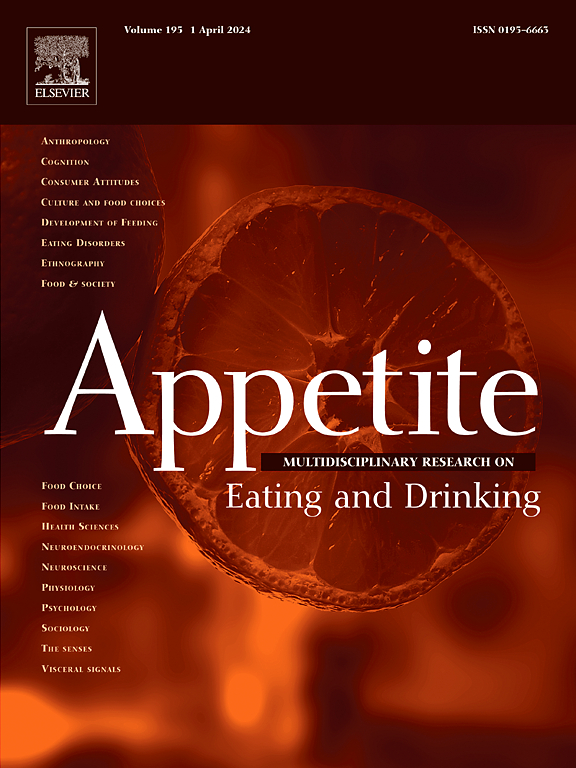年龄和体重指数与背外侧前额叶皮层对不健康食物的激活有关
IF 4.6
2区 医学
Q1 BEHAVIORAL SCIENCES
引用次数: 0
摘要
不健康的食物线索无处不在,并促进过度消费。虽然儿童肥胖率正在上升,但对向儿童推销不健康食品却没有严格的规定。这是一个问题,因为人类的大脑,特别是对认知控制重要的区域,在30多岁时还在继续发育。目前还不清楚大脑对不健康食物的反应随身体质量指数(BMI)和年龄的变化有多大。为了调查这一点,来自欧洲IDEFICS队列的168名儿童(10-17岁)和182名成人(30-67岁)在观看健康和不健康食品的图片时使用功能磁共振成像扫描。与成年人相比,儿童在接触不健康食物时表现出较低的右背外侧前额叶皮层(dlPFC)激活。在所有年龄组中,BMI指数较高的个体在不健康食物刺激下表现出中扣带活性降低。最后,与健康食物刺激相比,BMI与大脑在不健康食物刺激下的激活之间的关系随着发育而变化:在儿童中,较高的BMI与右前岛和右侧dlPFC的激活降低相关,而在成人中没有观察到这种关系。这些发现表明,身体质量指数较高的儿童可能特别容易受到不健康食物的影响。有鉴于此,缺乏针对儿童的不健康食品营销的监管令人担忧,特别是考虑到全球肥胖率的上升。本文章由计算机程序翻译,如有差异,请以英文原文为准。
Age and body mass index are associated with dorsolateral prefrontal cortex activation in response to unhealthy food cues
Unhealthy food cues are omnipresent and promote overconsumption. Although childhood obesity rates are increasing, there is no strict regulation of the marketing of unhealthy foods towards children. This is problematic since the human brain, especially areas important for cognitive control, continues to develop into the 30s. It is not known in how far the brain response to unhealthy food cues varies with body mass index (BMI) and age. To investigate this, 168 children (10–17 y) and 182 adults (30–67 y) from the European IDEFICS cohort were scanned with the use of fMRI while viewing pictures of healthy and unhealthy foods. Children exhibited lower activation in the right dorsolateral prefrontal cortex (dlPFC) compared to adults when exposed to unhealthy food cues. Across all age groups, individuals with higher BMI demonstrated reduced activation in the middle cingulum in response to unhealthy food stimuli. Lastly, the relation between BMI and brain activation in response to unhealthy compared with healthy food stimuli varied with development: in children, higher BMI was correlated with decreased activation in right anterior insula and right dlPFC, whereas no such relationship was observed in adults. These findings suggest that children with higher BMI may be particularly vulnerable to unhealthy food cues. In this light, the lack of regulation regarding unhealthy food marketing targeted at children is concerning, especially considering the global increase in obesity rates.
求助全文
通过发布文献求助,成功后即可免费获取论文全文。
去求助
来源期刊

Appetite
医学-行为科学
CiteScore
9.10
自引率
11.10%
发文量
566
审稿时长
13.4 weeks
期刊介绍:
Appetite is an international research journal specializing in cultural, social, psychological, sensory and physiological influences on the selection and intake of foods and drinks. It covers normal and disordered eating and drinking and welcomes studies of both human and non-human animal behaviour toward food. Appetite publishes research reports, reviews and commentaries. Thematic special issues appear regularly. From time to time the journal carries abstracts from professional meetings. Submissions to Appetite are expected to be based primarily on observations directly related to the selection and intake of foods and drinks; papers that are primarily focused on topics such as nutrition or obesity will not be considered unless they specifically make a novel scientific contribution to the understanding of appetite in line with the journal's aims and scope.
 求助内容:
求助内容: 应助结果提醒方式:
应助结果提醒方式:


